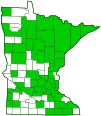black firefly
(Lucidota atra)
Conservation • Description • Habitat • Ecology • Distribution • Taxonomy
|
|
||||||||||||||
Description |
Black firefly is a medium-sized typical firefly. It occurs in the United States and southern Canada east of the Great Plains. It is common in Minnesota. Larvae live in decaying wood, in leaf litter, under stones, and in other moist areas. They prey on soft-bodied invertebrates, including snails and slugs. Adults are found from late May to July in shady open woodlands. Adults are soft-bodied, flattened, and 5 ⁄16″ to ½″ (7.5 to 13.0 mm) long. The head is covered by the exoskeletal plate over the thorax (pronotum). On both sexes the eyes are small and well separated. The mouthparts are directed downward. The antennae are black, have 11 segments, and gradually narrow toward the tip. The segments are thick, broadly triangular, strongly flattened, and straight across at the tip, not saw-toothed. They are never branched. The first segment is longer than the third. The second segment is very short, much wider than long. The pronotum is flat, not saddle-shaped, and broad, nearly as wide at the base as the forewings (elytra). It is black in the middle, orange or pink on the sides, with broad pale margins. The front of the pronotum is rounded, extended forward, and completely covers the head, though the head may be extended beyond it. The elytra are leathery and entirely black, without pale margins. The upper surface is finely granular and there is a weak raised ridge mostly near the base. The lateral margins are flattened. On the underside of the abdomen of the female there is a pair of small yellowish light organs on the last abdominal segment. On the male they are on the last two segments. The legs are black. The last part of each leg (tarsus), corresponding to the foot, has five segments, but the fourth segment is minute and is concealed within the lobes of the heart-shaped third segment, making it appear that there are only four segments. There is a pair of claws at the end of the last segment. The claws are not toothed or split. |
Size |
5 ⁄16″ to ½″ (7.5 to 13.0 mm) |
Similar Species |
Habitat |
Shady open woodlands |
Ecology |
Season |
Late May to July |
Behavior |
Adults are active during the day. Males do not flash except sometimes for one or two days after emerging. They fly in shady areas and rest on low vegetation and tree trunks. When threatened, they exude a milky juice from their abdomen and their legs. |
Life Cycle |
Adults emerge beginning in late May. Having lost bioluminescence through evolution, black firefly uses pheromones to find a mate. |
Larva Food |
Soft-bodied invertebrates |
Adult Food |
|
Distribution |
||
|
Sources Biodiversity occurrence data published by: Minnesota Biodiversity Atlas (accessed through the Minnesota Biodiversity Atlas Portal, bellatlas.umn.edu, 12/5/2024). |
|
| 12/5/2024 | ||
Occurrence |
||
|
||
Taxonomy |
|
Order |
Coleoptera (Beetles) |
Suborder |
Polyphaga (Water, Rove, Scarab, Long-horned, Leaf, and Snout Beetles) |
Infraorder |
Elateriformia |
Superfamily |
Elateroidea (click, firefy, and soldier beetles) |
Family |
|
Subfamily |
Lampyrinae (typical fireflies) |
Tribe |
Lucidotini |
Genus |
Lucidota |
Subordinate Taxa |
|
|
|
Synonyms |
|
|
|
Common Names |
|
black firefly |
|
Glossary
Elytra
The hardened or leathery forewings of beetles used to protect the fragile hindwings, which are used for flying. Singular: elytron.
Pronotum
The exoskeletal plate on the upper side of the first segment of the thorax of an insect.
Tarsus
On insects, the last two to five subdivisions of the leg, attached to the tibia; the foot. On spiders, the last segment of the leg. Plural: tarsi.
Visitor Photos |
||
Share your photo of this insect. |
||
This button not working for you? |
||
Greg Watson |
||
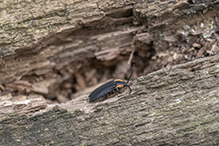 |
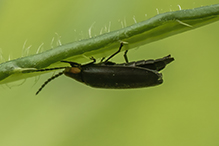 |
|
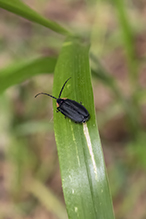 |
||
Alfredo Colon |
 |
Babette Kis |
||
Lucidota atra black firefly |
||
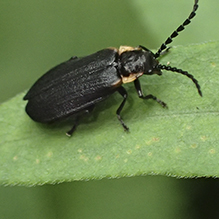 |
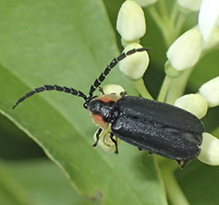 |
|
Lucidota atra Barnes Prairie Racine Co. WI June 25, 2020 |
Lucidota atra black firefly on Cornus racemosa, gray dogwood flowers June 7, 2021 | |
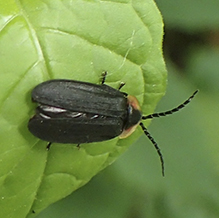 |
||
Lucidota atra black firefly Barnes Prairie near hedgerow July 15, 2022 |
|
|
MinnesotaSeasons.com Photos |
||
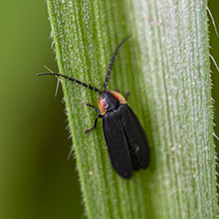 |

Slideshows |
|

Visitor Videos |
||
Share your video of this insect. |
||
This button not working for you? |
||
|
Other Videos |
||
Black Firefly (Lampyridae: Lucidota atra) Taking Flight |
About
Jun 18, 2010 Photographed at the Rydell NWR, Minnesota (16 June 2010). Go here to read more about this species: http://bugguide.net/node/view/5361 |
Black Firefly (Lampyridae: Lucidota atra) on Leaf |
About
Jul 2, 2011 Photographed at the Rydell NWR, Minnesota (29 June 2011). |
Black firefly (Lucidota atra) on black-capped raspberries, 6/25/20 |
About
Jun 28, 2020 |

Visitor Sightings |
||
Report a sighting of this insect. |
||
This button not working for you? |
||
Greg Watson |
Location: Magelssen Bluff Park |
 |
Alfredo Colon |
Location: Albany, NY |
 |
| Greg Watson 6/6/2023 |
Location: Magelssen Bluff Park |
 |
| Babette Kis 7/15/2022 |
Location: Barnes Prairie, Racine Co., WI near hedgerow |
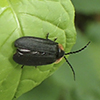 |
| Greg Watson 6/28/2022 |
Location: Great River Bluffs State Park |
 |
| Babette Kis 6/7/2021 |
Location: Barnes Prairie, Racine Co., WI on Cornus racemosa, gray dogwood flowers |
 |
| Babette Kis 6/25/2020 |
Location: Barnes Prairie, Racine Co., WI
|
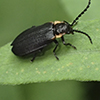 |
MinnesotaSeasons.com Sightings |
||

Created: 8/21/2022 Last Updated: © MinnesotaSeasons.com. All rights reserved. |
